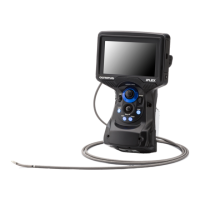Chapter 4 Operation
105
EVIS LUCERA GIF/CF/PCF TYPE 260 Series OPERATION MANUAL
Use of nonflammable gases (for CF/PCF models only)
Performing treatment while the intestines are filled with a
flammable gas could result in an explosion, fire, and/or
serious patient injury. If the intestines contain a flammable
gas, replace it with air or a nonflammable gas such as CO
2
before performing high-frequency treatment or laser
cauterization treatment.
Using CO
2
during endoscopic examinations of the colon and
rectum, etc., may reduce post-examination pain.
When a nonflammable gas is used, only the water container MAJ-902 may be
used with the endoscope. Carefully follow its instruction manual.
High-frequency cauterization treatment (except GIF-N260,
GIF-XP260)
• Performing treatment while the intestines are filled with a
flammable gas could result in an explosion, fire, and/or
serious patient injury. If the intestines contain a flammable
gas, replace it with air or a nonflammable gas such as CO
2
before performing high-frequency treatment.
• Not all parts of the endoscope are electrically insulated.
When applying high-frequency current, there is a danger of
unintentional diathermy burns. Always wear electrically
insulating, chemical-resistant gloves.
• Never emit high-frequency current before confirming that the
distal end of the high-frequency EndoTherapy accessory is in
the endoscope’s field of view. Also, confirm that the electrode
section and the mucous membrane in the vicinity of the target
area are at an appropriate distance from the distal end of the
endoscope. If the high-frequency current is emitted while the
distal end of the EndoTherapy accessory is not visible or too
close to the distal end of the endoscope, patient injury,
bleeding, and/or perforation as well as equipment damage
can result.
Prepare, inspect, and connect the electrosurgical unit and electrosurgical
accessories as described in their instruction manuals.

